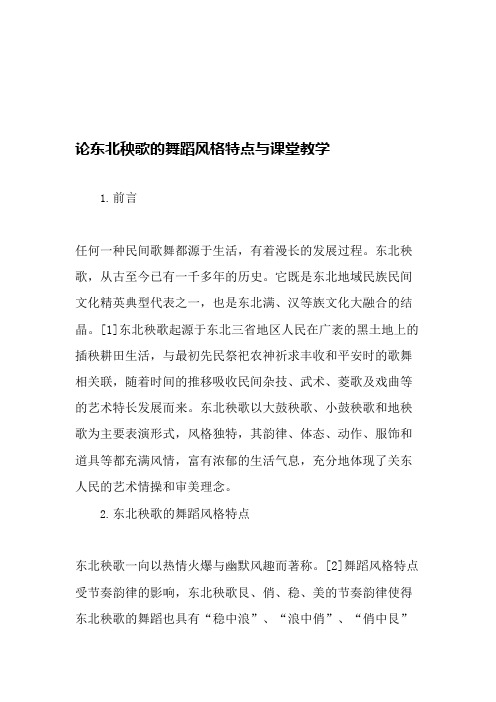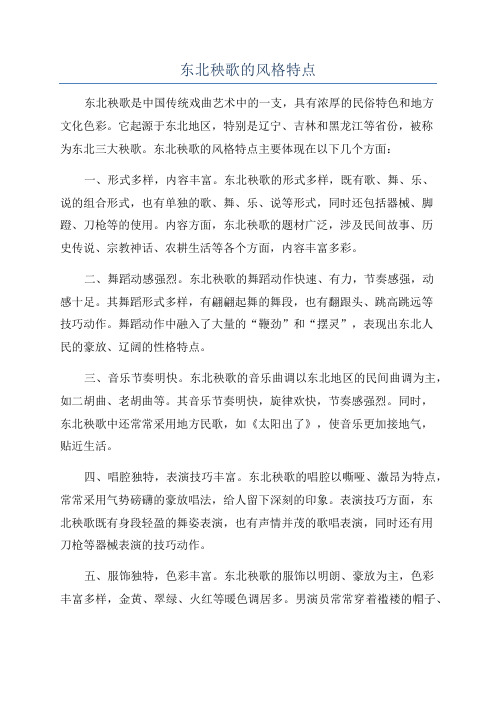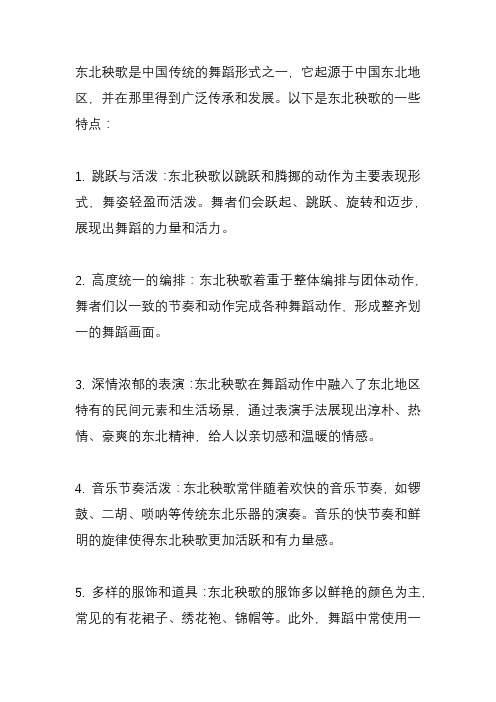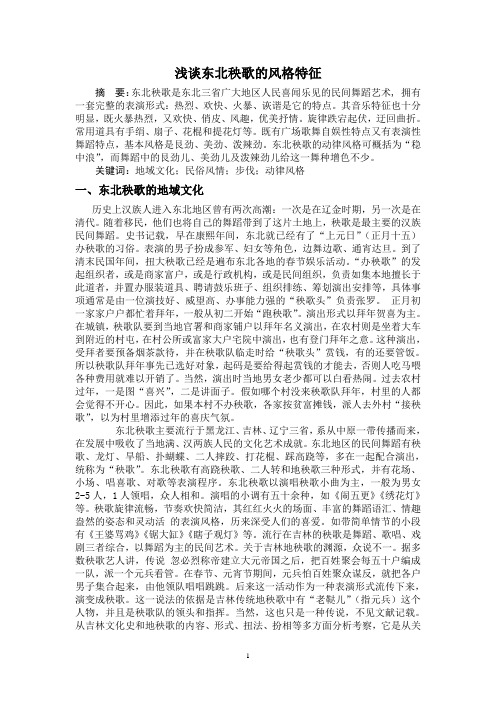东北秧歌风格特点 (1)
论东北秧歌的舞蹈风格特点与课堂教学-精选教育文档(可编辑修改word版)

论东北秧歌的舞蹈风格特点与课堂教学1.前言任何一种民间歌舞都源于生活,有着漫长的发展过程。
东北秧歌,从古至今已有一千多年的历史。
它既是东北地域民族民间文化精英典型代表之一,也是东北满、汉等族文化大融合的结晶。
[1]东北秧歌起源于东北三省地区人民在广袤的黑土地上的插秧耕田生活,与最初先民祭祀农神祈求丰收和平安时的歌舞相关联,随着时间的推移吸收民间杂技、武术、菱歌及戏曲等的艺术特长发展而来。
东北秧歌以大鼓秧歌、小鼓秧歌和地秧歌为主要表演形式,风格独特,其韵律、体态、动作、服饰和道具等都充满风情,富有浓郁的生活气息,充分地体现了关东人民的艺术情操和审美理念。
2.东北秧歌的舞蹈风格特点东北秧歌一向以热情火爆与幽默风趣而著称。
[2]舞蹈风格特点受节奏韵律的影响,东北秧歌艮、俏、稳、美的节奏韵律使得东北秧歌的舞蹈也具有“稳中浪”、“浪中俏”、“俏中艮”等风格特点,幽默泼辣又不乏沉稳之美,主要从其踢步、扭法、舞种等要素体现出来。
从东北秧歌舞蹈的主要步法“踢步”来讲,随着秧歌音乐干脆利落的节拍步法讲究俊俏、有力、稳健、活泼,即踢脚要快而有力,落地时间稍长,特点是单短双长,踢脚利索,体现出艮、俏、活泼,落地稳健优美;秧歌的扭法上,要上下身协调一致,上身成划横八字形,要扭出东北秧歌特有的“浪劲儿”并充满感染力,扭法与踢步结合起来,形成东北秧歌舞蹈动作自上而下的动感弧线;东北秧歌的舞种丰富多样,踩高跷、舞手绢、扇子舞、打鼓等方面充分体现了秧歌踢步和扭法的风格特点,舞手绢、扇子舞都能够充分体现出女子舞蹈柔美、娇羞、可爱、充满灵性的风格特点,打鼓、踩高跷都能体现男女的豪爽和乐观开朗,体现出秧歌舞蹈“稳中浪”、“浪中俏”、“ 俏中艮”的风格。
随着时代的发展,东北秧歌的舞蹈风格也因人们的审美观念和娱乐心理的变化而改变,对动作幅度更具夸张性,大幅度舞蹈动作的要求更大,小幅度舞蹈动作的要求更小,这样更加体现出东北秧歌舞蹈风格的幽默性和活跃性。
东北秧歌的风格介绍

东北秧歌的风格介绍东北秧歌是中国传统文化宝库中的一个重要组成部分,它独特的风格深受人们喜爱。
本文将对东北秧歌的风格进行详细介绍。
东北秧歌是流传于中国东北地区的一种传统表演形式,起源于秧苗时期的田间劳动,代表了东北地区的农民文化和智慧。
它通常由一群人在田野、街头、广场等开阔场地上表演,以歌舞形式表达劳动人民的奋斗和美好祝愿。
首先,东北秧歌的舞蹈风格独特,充满阳刚之美。
在舞蹈动作上,东北秧歌讲求气势磅礴,舞姿挺拔,力度十足。
舞者们高举着舞杆,舞动双臂,蓄势跃起或齐步舞行,动作刚健有力,展现出农民勤劳朴实的精神风貌。
同时,东北秧歌注重步伐的整齐,舞者们配合默契,节奏感强,充分展示了东北人民勇往直前、团结进取的精神。
其次,东北秧歌的音乐风格饱满激昂,富有地域特色。
秧歌音乐以鼓点为主,配以锣、铙、萨克斯等其他乐器演奏,曲调节奏明快,旋律朗朗上口。
音乐中融入了东北地方民歌的元素,独特的二重唱和合唱方式更是使音乐显得激情四溢。
秧歌音乐多为民间创作,歌词大多描绘农业生产、生活场景和人民情感,充满了浓厚的地方色彩和生活气息。
再次,东北秧歌的服饰和道具丰富多样,体现了农民的朴实风貌。
舞者身着传统农民装束,如青色或蓝色的单衣、白色或黑色的长裤,头戴花纹绣球、竹帽或黑色绣花巾,脚穿草鞋。
他们手持舞杆,上面装饰着彩带、彩球和漂亮的花朵。
此外,秧歌表演还常用红绸带、五角星、喇叭花、彩绸等道具,使整个表演更加生动活泼,增添了一抹喜庆的色彩。
最后,东北秧歌的表演形式多样化,融入了许多其他元素。
除了舞蹈和音乐,东北秧歌还常常伴随着杂耍、杂技、表演和游戏等形式。
例如,舞者可以在舞蹈中加入手绢舞、剑舞、柔术等杂技表演,或者利用道具开展搏击、叠人塔、倒立等表演节目。
这些表演形式的多样性使得东北秧歌更具观赏性和娱乐性,吸引了更多的观众。
综上所述,东北秧歌的风格独特多样,具有浓厚的农民气息和地方特色。
它以舞蹈、音乐、服饰和道具等多种元素相融合,展现了东北农民的勤劳和团结奋斗的精神风貌。
山东秧歌与东北秧歌的风格特征及区别

山东秧歌与东北秧歌的风格特征及区别首先是舞蹈形式。
山东秧歌的舞蹈形式丰富多样,包括单人独舞、对舞以及集体舞等。
其中,集体舞形式最为常见,通常由十人以上的群众组成,规模宏大,舞姿优美,动作矫健。
而东北秧歌则更注重对舞和集体舞形式的结合,动作力度大,舞姿有力,展现了东北地区勇敢豪爽的民风特色。
其次是音乐节奏。
山东秧歌的音乐节奏快速、活泼,以《山东鼓》为主要伴奏乐器,鼓声激昂有力。
而东北秧歌的音乐节奏更加狂放豪迈,以锣鼓和民族乐器为主,旋律强烈有力,给人一种磅礴的气势。
再次是表演特点。
山东秧歌的表演特点是注重舞蹈的艺术性和技巧性,并且舞蹈动作较为规范、精确。
舞蹈动作包括跳跃、转身、扭腰等,舞姿娇媚,线条流畅。
而东北秧歌的表演特点则更加豪放、激情四溢,动作幅度较大,常常伴有跳跃、旋转等高难度的动作,给人一种热情奔放的艺术魅力。
最后是文化内涵。
山东秧歌的舞蹈动作中,蕴含着丰富的农耕文化和民俗特色,表达着人们对丰收、幸福生活的向往和祝愿。
而东北秧歌则更加强调团结、勇敢和民族精神,表达了东北人民对生活的热爱和积极向上的态度。
总结起来,山东秧歌与东北秧歌在舞蹈形式、音乐节奏、表演特点以及文化内涵等方面存在一定的差异。
山东秧歌注重舞蹈的艺术性和技巧性,舞姿娇媚,动作精准;东北秧歌强调豪放、激情四溢的表演风格,动作幅度大,力度强。
这两种秧歌都承载着丰富的地域文化内涵,展示了不同地区人民的精神风貌和艺术审美。
无论是山东秧歌还是东北秧歌,都在民间舞蹈艺术的发展中占据着重要的地位,为传承和弘扬中国民族文化做出了积极的贡献。
东北秧歌的风格特点及发展分析

东北秧歌的风格特点及发展分析李怡非吉林艺术学院摘要:东北秧歌是一种较为流行的民间艺术,其语言风格幽默风趣,舞蹈热情火爆,展现了东北人民的热情、朴 实、幽默的性格。
本文就东北秧歌的风格特点以及发展进行分析。
关键词:东北秧歌 风格特点 发展中图分类号:J605 文献标识码:A 文章编号:1008-3359(2020)19-0010-03东北秧歌的历史较久,主要来源于民间人民的劳 动和庆祝活动,在秧歌不断发展的过程中吸收了非常 多的民间戏曲和流行因素,将不同的艺术进行融合,形成刚柔并济、热情幽默的风格,深受广大人民群众的喜爱。
因此,应加强对东北秧歌的传承与发扬,让更多人 了解并喜爱东北秧歌。
一、东北秧歌及其历史东北秧歌是一种民间的歌舞表演形式,深受东北 人民喜欢,在每逢重大的节日经常有秧歌的表演来为 大家助兴。
在如今东北地区的城市或乡村中,也会有许 多叔叔和阿姨在傍晚广场舞的时间扭秧歌锻炼身体, 秧歌在东北的流传度非常高,几乎每一个东北人都会 唱一小段或者扭上几下,这与秧歌自身风格特点是分 不开的。
秧歌的表演形式非常诙谐和幽默,风格较为独 特,既能淳朴豪放,又能生动活泼,在一定程度上代表 了东北人民的性格,非常的热情却爽朗又十分的质朴 稳重,体现出刚柔并济的特征。
东北秧歌的服装非常鲜 艳,大多数由色彩艳丽的戏剧服装为主,通常借助手巾 花、扇子、红绸、高跷等进行表演,观众一般能够通过服 装的样式来对表演中的人物角色进行了解,其中角色 多种多样,神话传说中的神仙妖精、历史流传的故事名 人等,在欢快的奏乐声中轻快的舞动,很容易营造出欢 快的气氛。
东北秧歌的历史可以追溯到康熙年间,杨宾于《柳边纪略》中有相关的记载,在宁古塔附近村庄的节日中, 有当地人民进行秧歌活动,详细的记录了秧歌中的扮 相特点、衣着服饰、音乐特点和欢乐的盛况,场面非常热闹有趣。
东北秧歌最早是由农民在农耕的过程中对丰收的期望和对农家生活的闲谈等发展而来的,属于 民间艺术,清朝时期,在东北的满族人较多,许多汉族 人民迁移到东北生活,带来不同的艺术和表演,东北秧 歌在发展的过程中吸收了很多不同的但又很有趣的表演形式,如祈福颂歌、民间杂技、武术表演、流行歌曲以 及各种戏曲等,表演形式多种多样,受众范围也较广。
东北秧歌的风格特点

东北秧歌的风格特点东北秧歌是中国传统戏曲艺术中的一支,具有浓厚的民俗特色和地方文化色彩。
它起源于东北地区,特别是辽宁、吉林和黑龙江等省份,被称为东北三大秧歌。
东北秧歌的风格特点主要体现在以下几个方面:一、形式多样,内容丰富。
东北秧歌的形式多样,既有歌、舞、乐、说的组合形式,也有单独的歌、舞、乐、说等形式,同时还包括器械、脚蹬、刀枪等的使用。
内容方面,东北秧歌的题材广泛,涉及民间故事、历史传说、宗教神话、农耕生活等各个方面,内容丰富多彩。
二、舞蹈动感强烈。
东北秧歌的舞蹈动作快速、有力,节奏感强,动感十足。
其舞蹈形式多样,有翩翩起舞的舞段,也有翻跟头、跳高跳远等技巧动作。
舞蹈动作中融入了大量的“鞭劲”和“摆灵”,表现出东北人民的豪放、辽阔的性格特点。
三、音乐节奏明快。
东北秧歌的音乐曲调以东北地区的民间曲调为主,如二胡曲、老胡曲等。
其音乐节奏明快,旋律欢快,节奏感强烈。
同时,东北秧歌中还常常采用地方民歌,如《太阳出了》,使音乐更加接地气,贴近生活。
四、唱腔独特,表演技巧丰富。
东北秧歌的唱腔以嘶哑、激昂为特点,常常采用气势磅礴的豪放唱法,给人留下深刻的印象。
表演技巧方面,东北秧歌既有身段轻盈的舞姿表演,也有声情并茂的歌唱表演,同时还有用刀枪等器械表演的技巧动作。
五、服饰独特,色彩丰富。
东北秧歌的服饰以明朗、豪放为主,色彩丰富多样,金黄、翠绿、火红等暖色调居多。
男演员常常穿着褴褛的帽子、蓝色的衬衣和长裤,女演员则穿着五彩缤纷的长袍、大红头巾等,形象鲜明。
六、情感表达深刻。
东北秧歌通过表演来表达人们内心深处的情感体验,使观众能够感受到其中蕴含的力量和感受。
“豪爽”是东北秧歌情感的主要特点,代表着东北人民乐观、豁达、激情四溢的精神风貌。
总体而言,东北秧歌具有独特的地方特色和浓郁的民俗风情,它不仅仅是一种艺术形式,更是东北地区人民世世代代的精神象征。
东北秧歌以其独特的舞蹈、音乐、唱腔、服饰等特点,成为东北地区民间文化中不可或缺的重要组成部分。
东北秧歌的风格特点

东北秧歌的风格特点东北秧歌源于中国东北地区,是民间的一种传统舞蹈,其舞蹈风格淳朴而富有民俗风情,具有浓郁的地方特色,在东北地区广泛流传并得到了人们的喜爱。
本文将介绍东北秧歌的风格特点,并讨论它对东北文化传承和发展的重要性。
一、舞蹈风格特点1. 好打好唱东北秧歌是一种充满活力与喜庆的舞蹈形式。
在秧歌表演中,歌舞融合,表现出来的舞蹈节奏明快,配合轻松愉悦的旋律,让人不禁跟着伴随旋律的节奏一起起舞。
而秧歌的唱腔华丽磅礴,充满感情,也是东北秧歌的魅力所在。
2. 坐俯卧东北秧歌在舞姿风格上,有一些独特的展现方式,其中最典型的就是“坐俯卧”形式。
秧歌表演者,会在演出时不断切换姿势,在节奏的控制下,能做出各种惟妙惟肖的动作,其中坐俯卧体位具有落地深入的特点,能够使得动作更为生动自然。
3. 编曲风格东北秧歌的音乐编曲风格一般取材于传统民谣,其旋律通俗易懂,让人容易上口。
在不同的时间和地方,往往伴随着不同的节令活动,其编曲也有所不同。
在农忙时节,一些秧歌节目就会产生一些特别的单曲和伴奏。
二、文化传承和发展的重要性东北秧歌作为东北地区民间文化的代表之一,不仅代表着东北地区的历史和传统,更是东北地区跳蹈文化的典型代表。
丰富的节目内容,不仅有着强烈的民族意识,而且也有很高的表演规格,能够充分满足人们对艺术审美的需求。
对于东北地区的文化传承和发展,东北秧歌也有着重要的意义。
它能够向人们展示出东北地区的民间艺术之美,促进文化的传承与发展。
同时,多样性的表现形式使得舞蹈呈现的视觉和听觉感受十分丰富,提高了人们的文化素养和审美水平。
通过推广东北秧歌,也能够提升地方的知名度和影响力,吸引更多人走进东北地区,了解和感受东北的独特魅力。
总之,东北秧歌在东北地区被广泛传承和发展,其独特的舞蹈风格和编曲特点,成为东北地区不可或缺的文化元素之一。
通过东北秧歌舞蹈的魅力传递,不仅能够展示东北的文化魅力,而且有着文化传承和发展的重要性。
东北秧歌的风格特点和表演形式

东北秧歌的风格特点和表演形式东北秧歌是中国传统民间艺术的一种,源于东北地区的农民活动和生产生活,形式上它是一种较为活跃、节奏明快的艺术表演形式。
在中国北方地区,每逢重要节日或喜庆活动,都会有东北秧歌的表演。
东北秧歌不仅具有浓郁的民间气息和地方特色,也是中国文化的重要组成部分之一。
一、风格特点东北秧歌的风格特点鲜明,表现出了东北民间文化的特色和情感。
其风格主要包括以下方面:1. 欢快热烈东北秧歌表现出了东北人民热情好客、豪放开朗的民风特征。
歌曲的节奏明快、歌词简单,能够让人们快速地融入其中,产生欢快的氛围。
表演者们在表演时,一般都表现出热情奔放的状态,有时甚至采用大力跳跃的方式,以表现出情感的强烈和热烈。
2. 多样化东北秧歌不仅歌曲和编舞都是多样化的,而且在表演形式上也相当灵活。
有的时候表演者会采用单独演出的方式,有的时候会采用群舞或群唱的方式。
表演的情感也不仅仅是欢快的,有时候会表现出沉郁和哀伤的情感。
因此东北秧歌不仅活泼,也富有感情。
3. 色彩浓郁东北秧歌在表演中大量采用明艳的色彩,以表现出东北人热情、豪放、开朗的性格特征。
例如,在服装上,表演者往往会穿上鲜艳的红色、黄色等暖色调的服装,使得整个表演场面富有色彩的同时,也能够让观众产生热烈、欢快的情感。
4. 表现力强东北秧歌在表现力上也非常出色。
表演者们在表演时,往往能够充分展现出自己的个性和情感,以表现出作品的魅力。
有时在表演中,表演者会采用鼓乐或器乐等方式加强节奏和气氛,让观众深受感染。
二、表演形式东北秧歌的表演形式也非常多样化,常见的有单人、双人、三人、四人和大型群舞的形式。
其中双人秧歌是比较典型的表演形式,表现出了东北地区大多数农村的欢乐场景和人们独特的态度。
在表演时,舞者们在歌曲的节奏下踩地,旋转、起扬和放手等,表演出各种形态,展现出蓬勃向上的青春和矫健俐落的姿态。
舞蹈形态简单朴实,但充满着独特的动感氛围。
表演者的舞蹈动作往往充满欢快的情感,让人们感受到了东北的谷地沟壑和广袤大地的气息。
秧歌的表演形式与风格特点

秧歌的表演形式与风格特点秧歌的表演形式与风格特点扭秧歌,是我国北方汉族民间喜闻乐见、具有代表性的一种舞蹈,是我国第一批进入国家级非物质文化遗产名录的项目之一。
以下是店铺收集整理的秧歌的表演形式与风格特点,欢迎大家分享。
秧歌的表演形式与风格特点秧歌的历史悠久,据清代吴锡麒《有正味斋集》载:“秧歌,南宋灯宵之村田乐也。
所扮有耍和尚、耍公子、打花鼓、拉花姊、田公、渔妇、装态货郎、杂沓灯术,以得观者之笑。
”由此可见,秧歌几乎有一千余年的历史。
秧歌的发展演变过程经历了三个阶段,即从伴随劳动生活的小曲到独立的民间歌舞演唱,由歌舞演唱逐渐向小戏过渡。
秧歌演唱的内容多为神话传说、民间故事。
具有反抗封建统治,歌颂农民起义的内容。
秧歌表现男女爱情大胆、直率,曾为历代封建王朝所不容,屡遭查禁。
到了近代,秧歌才有了较大的发展,尤其是1942年,在陕甘宁边区掀起了一场群众性的“新秧歌运动”,创造出具有革命内容,形式健康的新秧歌。
如秧歌剧《兄妹开荒》、《夫妻识字》等。
1949年后,秧歌的活动已不限于传统节日,在各种欢庆集会中都有秧歌表演。
秧歌已成为一些专业歌舞团体经常演出的保留节目,如东北大秧歌、山东鼓子秧歌以及脱胎于秧歌的《红绸舞》、《腰鼓舞》等。
秧歌的表演形式可分为地秧歌(徒步在地面上歌舞)与高跷(双腿缚以木跷,双脚踩在木跷上歌舞,亦名“踩高跷”)两种。
一般由十余人到数十人组成,舞者扮成生活中和神话传说里的各场,中间穿插各种小场。
大场是集体舞,由一至二名领舞者率领秧歌队边舞边走各种队形图案,如“二龙吐须”、“卷白菜心”、“门转子”等。
秧歌的基本动作为挥臂跳跃,扭腰甩肩,一步一拍,以四拍为一组,前三拍向前行进,后一拍退后一步。
小场为两、三个人的舞蹈和歌舞小戏表演。
此外,还有演唱情节比较简单的秧歌小剧,唱腔大都一剧一曲,或小曲联唱;也有吸收了地方戏曲的成分,发展成类似板腔体的结构。
过场音乐的打击乐曲目不多,常用的有《三点水》、《杀锣鼓》、《老三堆》、《凤凰乱点头》、《什样锦》等。
东北秧歌有什么样的特点?

东北秧歌是中国传统的舞蹈形式之一,它起源于中国东北地区,并在那里得到广泛传承和发展。
以下是东北秧歌的一些特点:
1. 跳跃与活泼:东北秧歌以跳跃和腾挪的动作为主要表现形式,舞姿轻盈而活泼。
舞者们会跃起、跳跃、旋转和迈步,展现出舞蹈的力量和活力。
2. 高度统一的编排:东北秧歌着重于整体编排与团体动作,舞者们以一致的节奏和动作完成各种舞蹈动作,形成整齐划一的舞蹈画面。
3. 深情浓郁的表演:东北秧歌在舞蹈动作中融入了东北地区特有的民间元素和生活场景,通过表演手法展现出淳朴、热情、豪爽的东北精神,给人以亲切感和温暖的情感。
4. 音乐节奏活泼:东北秧歌常伴随着欢快的音乐节奏,如锣鼓、二胡、唢呐等传统东北乐器的演奏。
音乐的快节奏和鲜明的旋律使得东北秧歌更加活跃和有力量感。
5. 多样的服饰和道具:东北秧歌的服饰多以鲜艳的颜色为主,常见的有花裙子、绣花袍、锦帽等。
此外,舞蹈中常使用一
些道具,如扇子、花球、长巾等,用以丰富舞蹈的表现形式。
通过以上特点,东北秧歌展现了东北地方文化的魅力和活力,是东北地区民间艺术的重要组成部分。
它既是文化传承的重要方式,也是人们表达情感和欢庆的一种方式。
第三单元 第一节 汉族民间舞——东北秧歌

3.前后动律 准备拍 正步位,双手持巾背手叉腰,双膝 微屈。 1拍 上身左侧向前扭身,压脚跟动律一次。 2拍 上身右侧向前扭身,压脚跟动律一次。 前后动律 4.划圆动律 准备拍 正步位,双手持巾背手叉腰,双膝微屈。 1拍 左肩带动上身走上弧线到前方,同时右肩走下 弧线到后方,压脚跟动律一次。 2拍 右肩带动上身后走上弧线到前方,同时左肩走 下弧线到后方,压脚跟动律一次。
划圆动律
5.屈伸动律 硬屈伸时双膝快速屈伸并富有弹性;软屈伸时膝关节的屈伸要有内在的柔韧感。 音乐重拍的动作身体重心向下,挺膝时双膝挺直以示动作的“哏、俏”特点。
(三)基本步伐动作
东北秧歌的基本步伐主要包括前踢步、后踢步、跳踢步、双颤步、顿步。 做踢步时双膝屈伸要短促而有弹性、松弛且有韧性,动力腿保持快而又力要快 踢、快收,形成一种“单短双长”的节奏,在空中停留的时间要短,收回落地 时快、稳而扎实,踢出的一刹那体现了“艮”、“俏”的特点。
东北秧歌的基本体态配合身体的“扭”,脚上动作利落扎实,膝部屈伸 的韧性,手中绢翻转,形成独有的律动表现。东北秧歌的身体动律主要是上 下动律,前后动律和划圆动律。
1.压脚跟动律 准备拍 正步位,双手持巾背手叉腰,
双膝微屈。嗒拍 双脚上提半脚尖,双腿 直膝并拢。1拍 慢提快落,重拍在下。
2.上下动律 准备拍 正步位,双手持巾背手 叉腰,双膝微屈。 1拍 上身向右提侧胸腰,随之向 左压侧胸腰,压脚跟动律一次。 2拍 上身向左提侧胸腰,随之向 右压侧胸腰,压脚跟动律一次。
(二)手巾花基本动作
1.里绕花 2.片花
3.缠花
4.交替花 5.蝴蝶花 6.蚌壳花 7.顶转花 8.立转花
里绕花 里绕花 缠花 交替花
交替花
蝴蝶花
蝴蝶花
东北秧歌的风格特点和表演形式

东北秧歌的风格特点和表演形式东北秧歌的风格特点和表演形式 东北秧歌⼀向以热情⽕爆与幽默风趣⽽著称,下⾯是⼩编为⼤家详细介绍东北秧歌的风格特点和表演形式,欢迎⼤家阅读! ⼀、东北秧歌的风格特点和表演形式 东北秧歌流传于我国的东北三省。
它热烈、⽕爆、逗趣、诙谐的独特风格特点。
并且形成了⼀整套完整的表演形式,蕴含着关东⼈民的审美⼼态和艺术情趣。
东北秧歌有其特定的,这种风格存在于各种动作之中。
东北秧歌形式诙谐,风格独特,不管春夏秋冬都有⾃发的秧歌队伍在路边或活动中⼼翩翩起舞,如果不同秧歌队伍相逢时,就会⿎乐齐鸣,以礼相拜,接着就是⼀通各显⾼低的竞技性表演。
观者为之叫好,表演者⾃娱其中,忘我投⼊,情趣万千。
同时它的表演形式⼀共有三种:“⼤⿎秧歌、⼩⿎秧歌、地秧歌。
(⼀)⼤⿎秧歌 ⼤⿎秧歌在三种形式中流传最⼴,尤其以辽南地区的营⼝、海城及盖县等地更为盛⾏。
主要通过使⽤的道具来与⼩⿎秧歌区分。
(⼆)⼩⿎秧歌 ⼩⿎秧歌分“天津⾼跷”和“⼩⿎⾼跷”两种。
表演者脚踩⼀尺六⼨左右的⽊制跷腿,因为两者都以腰⿎和⼿锣伴奏,所以统称⼩⿎秧歌。
(三)地秧歌 地秧歌是⼀种不踩⾼跷表演的秧歌,现在我们在课堂上所学的都属于地秧歌。
地秧歌⼜叫“地蹦⼦”,主要流传于沈阳、抚顺⼀带。
⼆、从动作及内⼼感受来了解并掌握东北秧歌的韵律特点 ⼈们的思想、审美、情感、观念都随着这个社会的快速发展⽽发展。
作为⼀名舞蹈演员也深刻体会到社会的进步。
中国有五⼗六个民族,汉、蒙、藏、鲜、维等等,可想⽽知民间舞的丰富多彩,同时也造就了不同的舞蹈风格。
⽽这个风格恰恰就是跳好民间舞的关键所在。
东北秧歌也⼀样,有其特定的风格,失去了这种风格就不再是秧歌舞。
今天的东北秧歌形式诙谐,风格独特,⼴阔的⿊⼟地赋予它纯朴⽽豪放的灵性和风情,融泼辣、幽默、⽂静、稳重于⼀体,将东北⼈民热情质朴、刚柔并济的性格特征挥洒的淋漓尽致。
稳中浪(活泼),浪中俏,俏中⾉,总体归纳为“⾉、俏、浪。
东北秧歌(1)

东北秧歌的种类及风格特点
东北秧歌分地蹦子和高跷两类。地蹦子又称
地秧歌,流传面较广;高跷盛行于辽南,特 别是营口(大石桥)、海城和盖县一带。说 的是某地有某水田农民插秧时唱田歌,叫秧 歌。 东北秧歌在风格上既有火爆、泼辣的特点, 又有稳静、幽默的特点。动作既哏又俏,既 稳又浪(浪,即欢快俊俏之意),而且稳中 有浪,浪中有稳,刚柔结合,不能扭扭捏捏 缠绵无力。
东北秧歌体态特征
东北秧歌体态的基本特征:始终保持前倾,
出脚时踢抬有力,收回时落地快而扎实,使 膝部规律的顿性和手绢花翻转时的爽利结合 起来,形成了东北秧歌特殊的体态动律,东 北秧歌的体态特征与原来秧歌表演中踩高跷 的动作技术也有关
东北秧歌的动律特点
上身动律:东北秧歌的身体韵律主要是左右摆动和 前后扭动 双膝屈伸:不同特点的双膝活动。硬屈伸时双膝快 速屈伸并富有弹性;软屈伸时膝关节的屈伸要有内 在的柔韧感,音乐重拍身体重心向下,挺膝时双膝 挺直以示动作俏特点 压脚跟:不同脚位的压脚跟。如正步、小踏步、大 八字等。压脚跟时后半拍双脚跟提,前脚掌着地, 双腿挺膝。前半拍迅速双脚落脚跟,提起脚跟的时 间要短,落地的时间要相对的长一些。
东北秧歌表演服饰
东北秧歌表演中的服饰,从整体 上看,色彩浓艳、明亮。除了领 头带队的人戴文生巾、披斗篷、 持折扇出场,其余表演者服饰整 齐,上(女)下(男)装统一搭 配。 上装,也就是女装,上身着镶边 夹袄,下裳基本为多褶长裙,一 般及至足踝;较为突出的是头上 的装饰,多以珠链或绢花编成凤 冠戴于头顶,有的冠状上用珠链 串成“孔雀”“凤”的展翅形状, 异常华贵。在女装的肩部均配以 珠链或绣花绢布制成的披肩,搭 于肩膀,头饰及披肩的颜色相对 浓艳耀眼,珠光宝气之色,醒目 华丽。
浅谈东北秧歌的风格特征1

浅谈东北秧歌的风格特征摘要:东北秧歌是东北三省广大地区人民喜闻乐见的民间舞蹈艺术, 拥有一套完整的表演形式:热烈、欢快、火暴、诙谐是它的特点。
其音乐特征也十分明显,既火暴热烈,又欢快、俏皮、风趣,优美抒情。
旋律跌宕起伏,迂回曲折。
常用道具有手绢、扇子、花棍和提花灯等。
既有广场歌舞自娱性特点又有表演性舞蹈特点,基本风格是艮劲、美劲、泼辣劲。
东北秧歌的动律风格可概括为“稳中浪”,而舞蹈中的艮劲儿、美劲儿及泼辣劲儿给这一舞种增色不少。
关键词:地域文化;民俗风情;步伐;动律风格一、东北秧歌的地域文化历史上汉族人进入东北地区曾有两次高潮:一次是在辽金时期,另一次是在清代。
随着移民,他们也将自己的舞蹈带到了这片土地上,秧歌是最主要的汉族民间舞蹈。
史书记载,早在康熙年间,东北就已经有了“上元日”(正月十五)办秧歌的习俗。
表演的男子扮成参军、妇女等角色,边舞边歌、通宵达旦。
到了清末民国年间,扭大秧歌已经是遍布东北各地的春节娱乐活动。
“办秧歌”的发起组织者,或是商家富户,或是行政机构,或是民间组织,负责如集本地擅长于此道者,并置办服装道具、聘请鼓乐班子、组织排练、筹划演出安排等,具体事项通常是由一位演技好、威望高、办事能力强的“秧歌头”负责张罗。
正月初一家家户户都忙着拜年,一般从初二开始“跑秧歌”。
演出形式以拜年贺喜为主。
在城镇,秧歌队要到当地官署和商家铺户以拜年名义演出,在农村则是坐着大车到附近的村屯,在村公所或富家大户宅院中演出,也有登门拜年之意。
这种演出,受拜者要预备烟茶款待,并在秧歌队临走时给“秧歌头”赏钱,有的还要管饭。
所以秧歌队拜年事先已选好对象,起码是要给得起赏钱的才能去,否则人吃马喂各种费用就难以开销了。
当然,演出时当地男女老少都可以白看热闹。
过去农村过年,一是图“喜兴”,二是讲面子。
假如哪个村没来秧歌队拜年,村里的人都会觉得不开心。
因此,如果本村不办秧歌,各家按贫富摊钱,派人去外村“接秧歌”,以为村里增添过年的喜庆气氛。
东北秧歌的风格特点

东北秧歌的风格特点东北秧歌是中国传统民间舞蹈形式之一,源自于东北地区。
它以洪亮的歌声、激情四溢的舞蹈和独特的表演方式而闻名。
东北秧歌有着丰富的风格特点,主要包括以下几个方面:一、音乐特点东北秧歌的音乐节奏明快,通常由锣、鼓、笛子、板胡等乐器组成的民间乐队伴奏。
音乐旋律优美、富有悦耳的旋律感,节奏感强烈。
在表演过程中,乐手们可以根据舞蹈的变化和情感的表达,通过即兴演奏来增强舞蹈的氛围感。
二、舞蹈特点东北秧歌舞蹈动作短促有力、姿态刚健,注重节奏感和舞蹈动势的表达。
舞蹈动作包括高举双手、劈叉跳跃、转圈等,具有较大的舞蹈幅度。
舞者身体协调性要求较高,要求舞者全身肌肉得到充分的动用,以保证舞蹈动作在表演中的完整性和高质感。
三、表演形式特点东北秧歌注重群体舞蹈的表现形式,通常由一支较大的群体共同表演。
表演的时候,舞者之间通过接力状的排列变化,以展现舞蹈的整体感和群体协作的美感。
在表演过程中,每个舞者都承担着不同的角色和动作,通过不同的舞蹈动作来表达自己的情感和角色的特点。
四、剧情叙事特点东北秧歌在表演中通常会根据不同的故事情节和主题来进行编排,表达剧情叙事的特点。
剧情通常表达东北地区农村生活、爱情、英雄事迹等内容。
在编排过程中,舞者们可以通过表演动作和舞蹈氛围来表达故事情节和角色的特点,以引起观众的共鸣和情感共鸣。
五、民俗文化特点东北秧歌是东北地区丰富的民俗文化的重要体现之一、在表演中,舞者们通常会穿上具有东北农民特色的服装,如破布衣、红军服、锦衣等,以展示东北地区的农耕文化和民族特色。
同时,东北秧歌在表演中也融入了一些民间元素和当地人的生活、习俗,增强了舞蹈的地域特色。
总之,东北秧歌以其独特的音乐、舞蹈、表演形式等多重特点而成为东北地区的重要文化遗产。
其丰富的音乐特色、独特的舞蹈动作、群体表演形式、剧情叙事特点以及民俗文化特色使得东北秧歌具有浓厚的地方特色和吸引力,深受广大观众的喜爱。
同时,东北秧歌也是东北民众传承和弘扬传统文化的重要途径,对于保护和发扬中国传统文化具有积极的意义。
汉族民间舞《东北秧歌》的风格特点及基本动律

汉族民间舞《东北秧歌》的风格特点及基本动律课时:一课时班级:二年级幼师班教学目标:一、知识目标通过学习掌握东北秧歌的基本动律及风格特点,分辨其与陕北秧歌和云南花灯的区别,明确舞种不同,风格不同。
二、技能目标掌握东北秧歌基本动律,压脚跟、身体上下动律、前后动律的特点,并在教学过程中训练学生的舞蹈表现力,做到训练就是舞台,培养学生良好的舞蹈习惯,提高学生的舞蹈素质。
三、情感目标通过本课时的学习,使学生明确舞蹈学习要认真仔细,稍不留意就跳错了舞种,使学生养成认真细致的学习习惯;同时通过掌握东北秧歌的风格特点及其与其它秧歌的区别,感受我们祖国丰富多彩的民族艺术,培养爱国主义情操与民族自豪感。
尤其在表现舞蹈的过程中,发现美,体验美,表现美,提高学生的审美能力,在反复的训练中也锻炼了学生的意志力。
教学重点:东北秧歌的动律特点。
压脚跟和身体上下动律、前后动律的学习。
教学难点:东北秧歌的稳、浪、艮、俏等特点的掌握。
教法:示范法、对比分析法、探究合作法、分组练习法、讨论法教学过程:一、导入课堂观看陕北秧歌、云南花灯、东北秧歌视频——提问进入教学。
东北秧歌教学(一)东北秧歌的特点欣赏一段东北秧歌视频,请同学们回答东北秧歌的特点。
——东北秧歌既稳重又幽默,既奔放又含蓄,以“脚下的艮劲”带动“上身的扭”与“手中的花”,动作上是收与放、静与动、强与弱的鲜明对比,体现出东北人民热情、质朴、刚柔相济的性格特征。
总结东北秧歌的主体风格特点就九个字:“稳中浪,浪中艮,艮中俏”(二)东北秧歌基本动律:1、身体上下动律2、身体前后动律3、划圆动律(三)动律组合学习1、身体准备位姿态2、叉腰位3、压脚跟4、身体上下动律5、身体前后动律6、综合练习(四)分组练习示范,大家点评,教师强调注意改正。
(五)分组根据基本动律创编动作,小组展示,教师点评。
(六)巩固知识教师小结。
(七)作业:练习。
(八)教学反思。
东北秧歌教学中的呼吸特点

东北秧歌教学中的呼吸特点东北秧歌教学中的呼吸特点东北秧歌的学习,一定要掌握呼吸的方式,下面我为大家带来了东北秧歌教学中的呼吸特点,欢迎大家阅读,希望能够帮助到大家。
东北秧歌,是流传于中国东北地区、具有代表性的一种民间舞蹈形式。
主要以艮、俏、稳、浪为其独特的风格特点,以“稳中浪、浪中艮、艮中俏”为主体风格,展现其独有的舞蹈风格和美。
(一)快吸气在东北秧歌的“踢步”训练中,音乐的弱拍是动作的强拍,这就要求学生首先学会分辨音乐与动作的强弱特点,做绕花时应与脚在瞬间踢出同步进行,马上形成相对应的舞姿,而脚落地收回时控制力度慢慢进行,使动作产生一种连绵不断的感觉。
踢出和收回的那一瞬间体内要有一个快呼气的过程,这个动作的用力过程非常快,而在身体快速转换重心的过程中,再把气慢慢吐出。
做绕花组合的训练时更应如此,以手指带手腕,慢慢起法儿,快速压绕的`同时压腕翘指,掌心向前完成一个完整的里绕花;动作的启动比音乐的节奏先开始,在弱拍“da”完成挑绕,正拍(即平常所说的重拍)下压。
当身体进行快呼吸时就是手腕绕花的过程,从压手腕到下一次绕花所走的弧线是慢吐气的过程。
通过呼吸完成踢步与绕花的配合,体现出东北秧歌“扭、稳、浪”的风格特点。
(二)停止呼吸在东北秧歌的“踢步”训练中,落脚收回时呼吸需要突然停止片刻,气息瞬间凝固的感觉;另外绕花组合的训练中更能感受到这一呼吸特点,手腕刚绕完的时候需要呼吸顷刻停顿瞬间,显得动作干净利落;这两个微小的动作充分体现了东北秧歌中停止呼吸的这一特点。
(三)慢吐气在动作时要求气息匀速地、慢慢地进行,优美舒展的片花组合中多运用这种平稳柔和的呼吸方式贯穿始终,表现了姑娘们稳中浪、浪中美的性情。
无论是脚下的踢步还是上身的扭动都运用短小的呼气和提气加以控制,以便将动作完成的干净、利落。
并且通过艺术呼吸的形式使动作的放与收、动与静、强与弱形成鲜明的对比。
从而使强烈的外在动作瞬间转为内在的韵律,将风格、节奏、情感融为一体。
- 1、下载文档前请自行甄别文档内容的完整性,平台不提供额外的编辑、内容补充、找答案等附加服务。
- 2、"仅部分预览"的文档,不可在线预览部分如存在完整性等问题,可反馈申请退款(可完整预览的文档不适用该条件!)。
- 3、如文档侵犯您的权益,请联系客服反馈,我们会尽快为您处理(人工客服工作时间:9:00-18:30)。
东北秧歌的风格特点摘要:东北大秧歌诞生于清康熙年间,起源于田间劳动和古人祭天,已有近300年的历史,现今广泛流行于东北三省,已经成为了我国东北地区的民间文化艺术之典型代表,深受东北地区人民的喜爱,在中国民间艺术宝库中的地位要远远高过我们的想象。
东北秧歌在舞蹈风格上既有奔放、洒脱的特点,又有平稳、幽默的特点。
动作既哏又俏、既稳又浪,而且稳中有浪、浪中有稳、刚柔结合,且不做作。
东北秧歌起源于东北、发展于东北,每一个情节都体现着东北人的质朴、勤劳以及豁达,每一个细节都将东北人的性格特征充分展现。
本文旨在通过研究东北严格的艺术风格特点加深人们对东北秧歌的认识。
本文从介绍东北秧歌的起源与发展入手,通过具体秧歌作品详细分析了东北秧歌的风格特点,最后介绍了东北秧歌在我国民间艺术舞台上的地位和贡献。
通过本文,将为继续研究东北秧歌提供有益的帮助和理论基础。
关键词:东北秧歌风格特点产生及发展风格形成贡献与地位Abstract:Northeast Yangko was born in the Qing Emperor Kangxi, originated in the field of labor and the ancients Heaven, nearly 300 years of history, now widely popular in the three northeastern provinces, has become a typical representative of the northeastern region of China folk culture and art, by the Northeast the favorite of the people of the region, in the Chinese folk art treasure is much higher than we can imagine. The Northeast Younger dance styles on both unrestrained, free and easy, have a smooth, humor features. Action both the main speaker and pretty stable and waves, and a steady waves, waves stable, rigid combination, and without affectation. The Northeast Younger origin in the northeast, the development in the Northeast, each of the episodes are reflected in the northeast of the simple, hard-working and open-minded, every detail of the Northeast character fully demonstrated. This article aims by studying the northeast strict artistic style features to deepen people's understanding of the Northeast Younger. Start from the origin and development of the introduction of the Northeast Younger, detailed analysis of specific Younger works the Northeast Younger style characteristics, and finally the Northeast Younger's position on the stage of folk art in China and. In this article, will continue to study the Northeast Younger provide useful help and theoretical basis.Key words:The Northeast Younger style features and development contribute to the formation of style and status前言东北大秧歌流传于我国东北辽吉黑三省,起源于插秧耕田的劳动生活,系从中原一带传播而来,在发展中吸收了东北当地满、汉两族人民的文化艺术成就,经过长时间几代人的积累,把民间艺人的表演升华为现在的东北秧歌,形成了一整套完整的表演形式,深受国内外人民的喜爱。
艺术来源于生活,东北秧歌这一艺术形式因具有浓郁的东北生活气息,在东北群众中具有较为广泛的群众基础[1]。
东北秧歌具有从属于自己的艺术风格和动律特点,与东北人民的社会生活、自然环境、风土人情、行为习惯是密不可分的[2]。
作为东北地区具有典型性的民间文化,东北秧歌素来以幽默、动感、亲切著称,其艺术风格特点紧紧围绕东北地区和东北人的性格特点,是东北地区最为主要的艺术形式之一。
在东北秧歌舞蹈中,艺术特色通过“三相”(即走、稳、鼓)和道具(手巾为主)所呈现。
稳中浪、浪中俏、俏中艮和踩在板上、扭在腰上是东北秧歌的最大特点,明快的鼓点、独特的体态特征、鲜明动律都是东北秧歌的风格特征[3]。
“艮”“俏”“浪”是东北秧歌最具代表性动作特点,东北秧歌是具有特殊的指导表演意义,在舞蹈动律的线路方面,体态中的把握、手绢花与动律的配合,步伐在节奏中上的变化都可以看出东北秧歌独具特色的风格特点。
本文通过对东北秧歌的历史与艺术风格进行介绍,旨在帮助人们重新认识东北秧歌。
1.东北秧歌的产生、发展及其渊源秧歌是汉民族民间流行最为广泛的一种舞蹈。
东北秧歌是东北人民十分喜爱的一种民间歌舞形式,起始于康熙三十年。
东北秧歌中的高跷盛行于辽南,特别是辽宁营口、海城和盖县一带。
说的是某地有某水田农民插秧时唱田歌,叫秧歌;地蹦子又名地秧歌,普及面较广。
就其产生而言,源于田间的劳动生活,主要是插秧耕田这一农活,加之古人祭天祈福要运用歌舞形式,因此,可能就有了最早“秧歌”一词的诞生;同时,在发展过程中,将农歌、民谣、菱歌、武术和民间戏曲等艺术形式不断纳入,逐步演变成了民间舞蹈——秧歌。
至清代,秧歌已在全国各地广泛流传。
东北秧歌以东北三省为主广泛传播,其主要道具为手绢花。
2.东北秧歌的艺术风格特点2.1东北秧歌北方地域特色浓郁东北大秧歌经过悠久历史的孕育,凭借红火的场面、极具内涵的舞蹈语言、引人入胜的姿态以及灵活的表演风格,甚为东北民众所喜爱。
东北秧歌是东北人心灵的表达,是生命情感自由宣泄的一种方式。
东北秧歌自产生以来,具有悠久的历史和深厚的生活积淀,深植于东北这片沃土,因此,具有十分鲜明的北方地域特色。
几乎每一个秧歌作品都是再通过舞蹈讲述着一个发生在东北的故事,观众每每欣赏完,一般都会有欢快、强烈、豁达的感觉产生。
今天的东北秧歌形式诙谐,风格独特,总体归纳为“艮、俏、浪”东北秧歌里的手绢花,花样繁多,多姿多彩,节奏也鲜明富有鼓点儿有弹性也是东北秧歌的一大特色特点。
如大型秧歌舞剧《关东女人》,将一位栩栩如生的“关东女性” 形象展现在舞台上。
该秧歌剧目中,女主角历经人生一系列悲喜遭遇,最后成长为一为对生活充满热爱、性格满载刚毅的东北女性。
随着剧情的深入和变化,自始至终,在关东女性的性格特征都得到充分展现的同时,东北的风土民情和地域特色也充分的展示给了观众。
2.2东北秧歌的体态特征将东北群众中最熟悉、最普遍的生产劳动、生产工具和生产对象进行提炼,产生了东北秧歌的体态。
因为高跷的影响,秧歌的表演者为使重心稳定,在踩高跷时,要前倾上身、微收下颚,出脚提抬有力、收回快且扎实,保证进行动作时的灵活与利落。
正因如此,在东北秧歌中形成了女性泼辣、大方的体态动律特殊,男性洒脱、豪放、阳刚。
这样就形成了一种与东北人民坚忍不拔性格相一致的“哏劲”。
扭秧歌的“扭”字有扭腰的意思,扭即扭在咬眼上,扭字最能体现东北人的热情、奔放、豪爽、泼辣、欢乐、乐观、直爽、豁达、浪俏、幽默的性格。
例如,在《大姑娘美》这部作品中,演员王晓燕充分利用了眼睛这一传神器官,颦笑嗔娇的表情和舞蹈动作的爽朗利落,加之极具东北秧歌特色的体态,充分演绎了东北姑娘对爱情的渴望与执着,充分表现了东北大秧歌的风格。
2.3东北秧歌的动律特征动律分为上下动律、前后动律、划圆动律,三个动律之间的衔接都要经过腰部的下弧线慢移动,然后快速形成舞姿。
2.3.1 走相“走”是东北秧歌中的一种动态动作,为一种时而呈“十字扭”、十二呈“横8字扭”的基本步法。
在“扭”这一动作进行时,舞者膝部松且顿、脚腕部有力;在进行脚后踢动作时,落地与膝部控制的脚后踢同时进行,整个动作的完成极富艮劲;在步伐上,东北秧歌放中带收,跑时具有极富夸张性的动作;扭动过程中,路线不断变换,队形美观样式多,给人以期待感。
2.3.2 稳相“稳”,即表现了东北秧歌中的静态动作,是相对于“走”这一动态动作而提出的[4]。
胸前立掌、单扶肘、双扣手等动作都包含在了“稳”中,“动”为“稳”所瞬间转换,两种形态相融相映,带给观众视觉上的冲击感。
2.3.3 鼓相在东北秧歌中,鼓是必不可少的,击打鼓时的节奏更是韵律十足。
不同的含义是由各具差异的鼓点表现形式传递的。
鼓相动律的种类包括叫鼓、连鼓、翻身等。
2. 4手巾花作为东北秧歌中的主要表现载体的手巾,其艺术展现由手巾花完成。
手巾花多样的动作和舞法是通过手部、腕部与手巾的结合实现的,其技巧令人称其和赞言[5]。
手巾花拿法、耍法、扭法,融于舞蹈组合中,令观众感受东北人的那种浓郁的生活气息、内心情感和表达方式。
秧歌作品《下雪了》,可以称得上是东北秧歌中手巾花艺术的杰出作品。
在此舞蹈剧目中,“旋花、顶花、立花、立旋花”等唯美的手巾花手法与多变幻化的队形相结合,令现场观众无不感受到了北国雪景的再现。
东北秧歌中对手巾花的运用十分充分,仅是手巾的持巾方法就有六种之多,有握巾(分为两种:全把握巾和半握巾)、捏巾(也可称三指提巾)、抓巾、指挑巾、托巾、夹巾(分为虎口夹巾和二指夹巾等)。
手巾花的各种拿法加上手腕的灵活运动可以产生各种各样的手巾花。
手巾花丰富的舞法有:里(外)绕花、里(外)片花、碎绕花、小五花、单掏花、抖花、掸巾、甩巾、搭巾、撩巾、立片舀花等,如小五花:握巾,双手体前交叉,右手在上,掌心在下,左手在下,掌心向上,右手向里左手向外划成手心相对,手腕相靠,再左手向里,右手向外继续划,经左手在上掌心向下,右手在下掌心向上划至手背相对手腕相靠。
